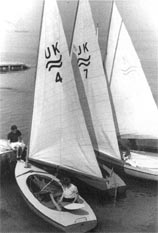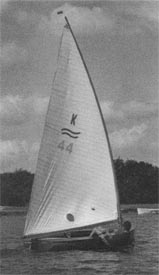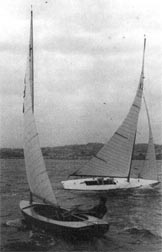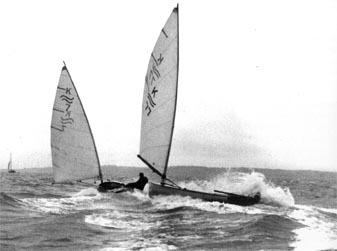| 14. Finn Memories |
by Vernon Stratton |
|
Looking back fifty years and trying to remember stories that haven't been written is not easy. I can't remember how many years I was Secretary or President of IFA let alone how long I looked after the production, advertising, photography and editorial of FINNFARE. Luckily I don't need a lot of sleep.
The one thing I do know is that the Finn, like the Star class, has always had a fantastic organisation that is prepared to move with the times and keep ahead. It is this that has kept it as an Olympic Class for so long. I also think it has something to do with going up the last beat of a Gold Cup course. Finn sailors never give up till it's over. At seventy one I still race all the winter in an Illusion (mini Twelve). I don't win anymore but I race against some the world's best sailors. What more can you ask for?
Memories
In 1950 I sailed in my first single handed open meeting in a Firefly, the 12 foot dinghy that was used for the 1948 Olympics at Torquay in England - the Class in which Paul Elvstrom won his first Gold Medal. He was really a Dragon sailor but was put in the Firefly Class because he was the youngest!
|
Martin Beale, the winner of that Firefly race, held in very strong conditions, came up to me afterwards and suggested that I bought a Finn. I think that this must have been because I had survived the race (by bailing with a saucepan on the end of a broomstick!) as most of the 48 entries were wiped out! So I bought one!
This was to change my life. I met Charles Currey one of the World's best dinghy sailors at the time and I met my wife Pepe. We all practised in Finns throughout the winter of '51, something that was unheard of at the time. Charles won the Silver medal and Pepe beat Stewart Morris, the Swallow Class gold medalist in the '48 Olympics, in the Olympic trials. Not a bad result for a girl and that was in the days before the bendy mast. Pepe and I were engaged by the Olympic Trials and were married in 1952.
The Finn that I bought was one of four built by the Tormentor Yacht Station and cost £150 complete. Charles exploited the tolerances to the maximum, making them very fast boats rather like the Raudaschls in the sixties. Jack Knights eventually bought Charles' Finn and . took it to the USA where he raced it very successfully. I believe it was used as the mould for the Newport Finns of Fred Miller fame. They were unbeatable until the measurer found lead in the floor!
|
 |
| Vernon Stratton sailing in the Solent in 1951 |
|
Elvstrom at Zeebrugge
In the early fifties we used to race in Belgium at Zeebrugge, which was organised by the Commodore of the Royal Belgium Sailing Club. Travel was quite expensive and I used to pay for my trip by selling the latest invention made by a man called Mr Lewrie who worked out of an old wooden shed near the sea at Emsworth on the south coast of England. In those days he would make one offs for dinghies. Who would have thought that that would have been the start of Lewmar the international company that now supplies the best yachts in the world. |
I remember one year at Zeebrugge in early May it was freezing cold and blowing a gale from the north (it nearly always did). The course was set inside the harbour mole which gave us a beat in very hairy conditions then a reach along under the harbour wall and back for the jibe and run to a turning mark by the lock gates. This was the last race I ever reefed a Finn. It was quite easy in those days. All you had to do was pull the boom out of the slot in the mast roll up the sail on the boom and put it back using a claw for the main sheet and then stuff in the wedge, Charles Currey's invention, instead of a kicking strap.
Paul capsized before the start gun. I breathed a sigh of relief as I then only had Borge Schwarz to contend with. We had a great race. I was quicker on the wind and he flew on the ran. The turning mark was his undoing because he got out of control and nearly went up the harbour wall by the lock gates. I survived the next round to win the race.
I came ashore full of confidence thinking that I would win the regatta, but not a bit of it. The super human Paul who was never beaten, swam his boat ashore, pulled it up the Harbour wall and emptied the boat. He went to his car and got out a dry mainsail, launched it again single handed and calmly sailed round the course under full sail while I was in the shower thinking I was the Regatta winner!
|
 |
| UK Olympic Trials in 1952 John Oakley (left) and Vernon Stratton (right) |
|
He finished sixth and as so few boats had completed the course he thus got enough points to hold onto his lead. Elvstrom was unbeatable in those days to such a extent that he used to get angry with himself if he only won six of a seven race series. Go home and train so that he was better! |
I did beat him once! That was on the Lymington river when he took a short cut and didn't notice the ferry coming in so he was blanketed and had to wait until it had gone. Hardly a glorious win for me, but I did beat him. In those days one had to clutch at anything to boost one's morale.
Finn Gold Cup Starts
In 1956 I thought the class should have a World Championship and we were lucky enough to have in England a man of incredible generosity. Tiny Mitchell was a big man in every sense. He had built ten Finns for our Olympic Trials so that the top twenty dinghy sailors in the country could practice. I felt that he was the man to approach. I felt that we should give the type of hospitality that we were given when abroad. The net result was that all overseas entries were given financial help to come to this country, free transport when the boat arrived, and a trip to the Palladium in London to the best show in town.
The only snag was that the racing had to be held at his favourite Club at Burnham-on-Crouch at Easter. This was not the ideal venue as it was impossible to get an Olympic course. Andre Nelis won the regatta, Paul was second, it snowed, Pepe got locked out of the Hotel in her night dress walking the dog and I remember sitting on my boat upside down with the mast stuck in the mud. It was a great start to one of the most difficult Cups to win in sailing.
|
 |
UK Finns gather
at Cowes in 1952 |
|
Elvstrom in Copenhagen
The Finn Gold Cup in 1959 was the biggest entry on record to that date, we also held a record number of starts for the Regatta - twenty nine! You don't have to ask who won, Paul of course with his secret weapon. I remember it so well before the start of the practice race (Oh yes, he had to win that too!) I was watching Paul, when suddenly I thought he had fallen out of the boat backwards he then surfaced shook his head and went in to the start. That was the start of heavy jackets. Once we realised what he was up to we all went mad with more and more layers of towelling to try and get heavier than Paul's sweaters.
1960 Gold Cup
I still have the string sweater that I used to help win the 1960 Gold Cup in Torquay against the Norwegian giant Harold Bredo Eriksen. The other reason why I won was because I had a new mitre cut Dacron sail from Hans Fogh. Andre Nelis was using a cotton sail. In those days the deed of gift was that the Gold Cup should be held in the UK in the Olympic year to give us an advantage and save travel costs.
1968 Gold Cup
That was the year the tide went out! It was also the year I started my business so sailing was out. I was however on the International Race Committee as President of IFA. I was sent for and hastily motored down from London to hear the protests against the day's race. There had been delays because of lack of wind and the race had gone on a long time. I listened to reports of Finns getting caught the wrong side of sandbanks and helmsmen having to take off their fixed rudders to cross the finishing line. The final straw was when the linesman on the far end of the finishing line reported that he stepped over the side and walked back to the Committee boat. Those were the days! and that was the end of Gold Cups in Britain every four years.
|
 |
Gilbert Lamboley
Gilbert will go down in the history of yacht racing as the man who invented the method of measuring weight distribution and thus keep a one design class equal. It is the pure simplicity that shows a man's genius and simple it is. Anyone who has helped measure a Finn at a World Championship will agree. Gilbert was running his own business and gave up too much time to the Finn class. He completely rewrote the rules of the class and it is through his work that we are still an Olympic Class.
A funny story. We went to the Finn Veterans in the South of France in 1974. Both Gilbert and I were surprised by the speed of one of the French sailors. We discovered that he had got his mast from the National Team and it was very fast. We then heard that the team coach had been to Needlespar and tested 200 masts to select six. We had to find out why they were different, so in the middle of the night after a good dinner we did the weight test on the mast.
|
 |
|
Sure enough it was different, so when Gilbert was next in England we bought a new Needlespar, measured it and then proceeded to make it perform to the magic measurements. We found two large planks of wood and proceeded to hammer them with a sledge hammer until the figures were the same! A test race proved the French knew what they were doing - it was fast! 'Don't try this at home' as the TV programme says, as it get you very far with carbon fibre. It does prove however that the correct mast bend is what makes the boat go.
|
Jorg Bruder had a magic wooden mast. He tested 250 of his own masts against it, it was always faster. After two Gold Cups he sold it to Patrick de Barros.
This story is what inspired me to recommend to the German Olympic organisers in 1971 that a metal mast was the most likely innovation to give the fairest racing as they were more likely to be all the same.
1973 Gold Cup
I remember driving to Brest and passing the Brazilian Finns being double trailed along the road. It was moments later that I heard on the radio that a Brazilian plane had just crashed coming into Paris. I immediately said to Pepe that I pray to God that Jorg Bruder is not on that plane. He was and with the Gold Cup. What a tragedy. He was one of the finest sailors I'll ever know. He was so modest so kind and helpful to everyone and a brilliant sailor. I shall never forget him. That was the year that I was allowed to sail with a new double bottom Finn as a test to see if they should be allowed into the class.
|
 |
Richard Creagh-Osborne (K 7) and
Jeremy Rogers (K 77) Photo by Vernon Stratton |
|
It passed the Lamboley test and it didn't seem to make a difference to performance. Now we all have double bottoms, a long way from the original Finns with no buoyancy at all.
1977 Weymouth Olympic Week
Still racing and just about to be fifty. I can't remember where I finished the week but I wasn't doing too badly for an old man till one day I capsized with my heavy jacket on. I had always been against them and had persuaded Gilbert Lamboley to do a paper for the IYRU (ISAF now). They had listened and put on a weight limit, but not enough in my view. Well I couldn't get back in the boat even after taking it off. As there were quite a lot of capsizes that day I had to wait. This gave me time to think about what I was doing at my age, especially as I was Chairman of the Olympic Committee and manager of the team. It is one thing capsizing when you are young; old men should realise that they can be a liability. It was at this moment that I decided to give up racing a Finn - my love for twenty six years. Pepe could see that I was very upset by my decision so decided that I should have an early fiftieth birthday present, a Star. So I started a new love affair that lead to a Gold Medal in Korea - not for me but for Bryn Vaile my Star crew and ex Finn sailor. |